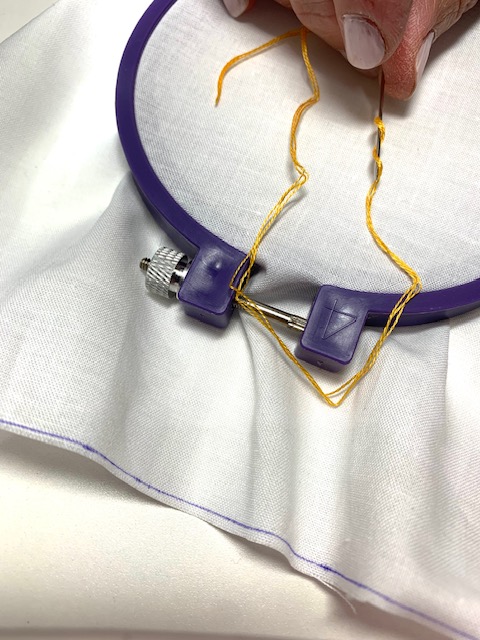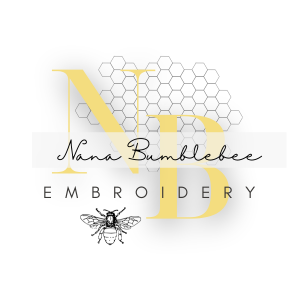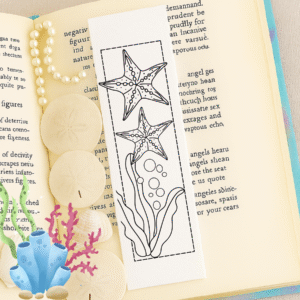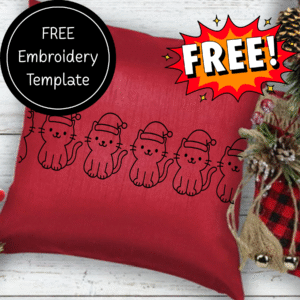So you’ve found the perfect embroidery pattern—maybe it’s a charming bumblebee, a seasonal motif, or a whimsical animal—and now you’re wondering: How do I get this design onto my fabric?

Good news: there are several easy ways to transfer printed embroidery designs, and you don’t need fancy equipment to get started. Whether you’re stitching on cotton, linen, or something more textured, there’s a method that will work for you.
As an Amazon Associate, I earn from qualifying purchases
Let’s explore the most beginner-friendly options, with product suggestions you can try today.
1. Tracing with a Light Source
Best for: Light-colored, smooth fabrics like cotton or linen.
What you need:
- Your printed design
- A light source (window, lightbox, or tablet)
- A fabric marking pen or pencil
How it works: Tape your printed design to a window or lightbox, then place your fabric on top. The light will shine through, making it easy to trace the lines directly onto the fabric.
Recommended tools:
- Lightbox for tracing (great for frequent use)
- Water-soluble fabric pen or heat-erasable pen
Tips: Use painter’s tape or Scotch tape to hold everything in place. If you’re using a heat-erasable pen, test it on a fabric scrap first to make sure it disappears cleanly.
2. Printable Transfer Paper
Best for: Detailed designs or dark fabrics.
What you need:
- Inkjet printer
- Iron-on transfer paper
- Iron and hard surface
How it works: Print your design onto the transfer paper (make sure to mirror it if it includes text), then iron it onto your fabric. The design will transfer directly—no tracing required.
Recommended tools:
- Iron-on transfer paper for embroidery
- Mini craft iron for precision
Tips: This method works best on smooth, flat-weave fabrics. Avoid textured surfaces like terry cloth or felt.
3. Transfer Pens and Pencils
Best for: Reusable patterns and simple line art.
What you need:
- Transfer pen or pencil
- Printed design
- Iron
How it works: Trace your design onto regular paper using a transfer pen. Place the traced side face-down on your fabric and iron it to transfer the ink.
Recommended tools:
Tips: This method creates a permanent line, so make sure your tracing is accurate. Great for designs you plan to stitch over completely.
4. Water-Soluble Stabilizer
Best for: Intricate designs or textured fabrics.
What you need:
- Water-soluble stabilizer sheets
- Inkjet printer
- Needle and thread
- Bowl of warm water
How it works: Print your design directly onto the stabilizer, then stick or baste it onto your fabric. Stitch through both layers, then soak the finished piece in water to dissolve the stabilizer.
Recommended tools:
- Sticky Fabri-Solvy sheets
- Embroidery hoop to keep everything taut
Tips: This method is ideal for felt, denim, or any fabric that’s hard to trace on. It’s also great for preserving delicate linework.
5. Carbon or Transfer Paper
Best for: Quick transfers on light fabric.
What you need:
- Dressmaker’s carbon paper
- Stylus or ballpoint pen
- Printed design
How it works: Place the carbon paper between your fabric and printed design. Trace over the lines with a pen, and the pressure will transfer the design onto the fabric.
Recommended tools:
- Dressmaker’s carbon paper
- Tracing stylus
Tips: Use a light hand to avoid smudging. This method works best for simple outlines.
Tips: Use a light hand to avoid smudging. This method works best for simple outlines.
Final Thoughts:
There’s no right or wrong way to transfer designs. I started out by taping my hand-drawn designs onto a sunny window, taping the fabric over it, and then transferring the designs onto the fabric. I have since moved onto my light table, and I print designs onto water-soluble paper from my inkjet printer. Just go with whatever works best for your budget.
One of my favorite tips to use for any pattern: If you see a flower, piece of grass, etc, that you don’t like, don’t stitch it! Make each pattern “your own” by tailoring it to your needs or likes. Sometimes I only stitch one element from a pattern, like say if I just like the flowers, I will only draw just that onto my fabric rather than what the subject is about. Embroidery is about being creative, YOU choose what you stitch or don’t stitch.
If you’re not quite sure about hand embroidery and want to start with some easy designs, I’d like to recommend some beginner ones for you here:
If you’d like to be updated about the new free embroidery patterns here, please subscribe to my email list. Each of my patterns is protected, so you will need to subscribe to get the password. I promise not to spam! I am lucky to write 1 email a week.







